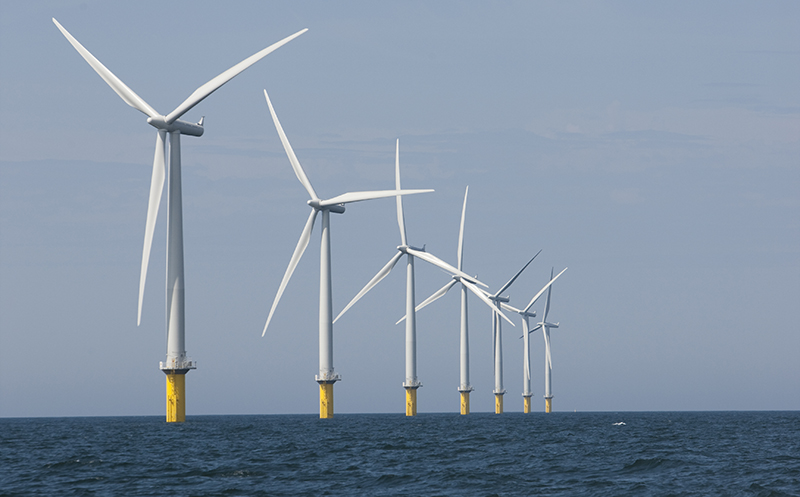Coming on the heels of worldwide publicity brought by President Biden’s announcement of plans to help grow the offshore wind sector, companies and colleges are working together and independently to teach future offshore wind professionals the tools of the trade. Some of them have been doing so for a while, but experts say it’s not happening fast enough.
According to a March 2020 study by the American Wind Energy Association — now part of the American Clean Power Association — market projections for development of 20,000 to 30,000 megawatts of operational offshore wind by 2030 bode well for job-seekers now and in the future. That growth is occuring on its own, with help from state and local governments and investors capitalizing on an increasingly affordable new energy source. These folks are players in the competitive global market for green energy in which many companies are elbowing each other for dominance — especially in wind power.
The stakes of this endgame are huge. According to the AWEA study, the offshore wind industry will invest between $28 billion and $57 billion in the U.S. economy from now through 2030. Offshore wind project development, construction and operations will generate 19,000 or more jobs by 2025, and as many as 45,000 or more jobs by 2030. Investment in the U.S. offshore wind industry is projected to produce between $5.5 billion and $14.2 billion per year in economic output by 2025.
Lower-paying part-time jobs are not part of the equation.
“These new jobs will be long-term, well paying, and offer new employment opportunities for the right candidate,” said Eric Lawrence, managing director of Buzzards Bay Transfers, New Bedford, Mass., which provides vessel and logistical support for the offshore wind industry.
The U.S. needs many more pros that are trained in offshore wind installation and maintenance. The U.S. needs them now and in the future. The vast majority of these workers will have to be U.S. citizens, since it’s not feasible to speedily build the offshore wind sector here without them.
“The reality is that apart from the relatively small number of foreign personnel involved as crew of foreign-flagged windfarm installation vessels, pretty much the entire workforce required to support the U.S. offshore wind industry will need to be U.S. workers,” said Michael Saint James, principal consultant of Saint James Marine LLC, a Decatur, Ga.-based offshore wind consultant. “As planning for U.S. offshore wind projects has become more advanced and the tangibility of specific projects has come closer, there’s been an increasing recognition of the significant gap in workforce development.”
Fortunately, there is an industrywide awareness of the problem, and many different efforts to fix it. Those efforts are gaining momentum and ultimately connect to the overall push to teach the public about offshore wind, how it works and why it’s important to use. With the polarization of U.S. politics these days, intransigence from both the right and the left, the notion of offshore wind sector overdependence on federal government help isn’t the most practical long-term view of funding for the new sector, even if it’s a great idea.
There might be no funding for offshore wind in any infrastructure bill passed into law, or no passed bill, possible facts which the sector must plan on. Thankfully, many companies and institutions are working on the task of education offshore wind’s next generation of workers.
Several educational institutions have offered programs that teach students about offshore wind for a while. But today, the programs are multiplying to meet a growing demand for workers. Bristol Community College, Northeast Maritime Institute, and Massachusetts Maritime Academy started training programs to help others get jobs in the growing offshore wind sector. Siemens Gamesa has taken a lead in such efforts, too, with its own school, Wind Academy by Siemens Gamesa.
Many other programs are proliferating in the sector, with new ones from week to week sometimes. Recently, the New York State Energy Research and Development Agency (NYSERDA) announced a $20 million initiative with the State University of New York Maritime College. Maersk Training announced it has partnered with Bristol Community College to focus on offshore wind occupational training. Crowley Maritime has partnered with RelyOn NUTEC, Houma, La., to provide offshore wind training. On top of all of that, the New Jersey Economic Development Agency now has an offshore wind job training effort to involve community technical schools in offshore wind training.
Currently, the U.S. Department of Energy is predicting hundreds of thousands of jobs will be supported by the wind energy sector in the next 20 years. The DOE’s Wind Vision Report predicts a strong wind energy sector for a long while into the future. More than 600,000 wind-related jobs could be supported by 2050, according to the DOE.
The overall wind energy sector currently supports more than 500 wind manufacturing facilities and 50,000 jobs. Those jobs are in installation, maintenance, and manufacturing.
Will educators and companies in the U.S. be able to meet the demand for all of those workers? It seems likely, the way they are picking up the pace.
“It’s prudent to balance large amounts investment for offshore wind training, [matching them] with when relevant positions for those personnel will be available. Invest too early and the time value of money is being squandered, while freshly acquired skill-sets that are not able to be effectively applied quickly begin to fade. Such an approach undermines the initial objective of having an appropriately trained workforce,” Saint James said.
Many other industry pros agree with the view. Too much training too fast could create its own problems, but the sector is not there yet.
“There are many organizations, webinars and online events focusing on offshore wind. States and developers are investing in STEM programs focused on climate change, sustainability, energy generation and offshore wind. We are also starting to see Offshore Wind Training Institutes being established in various states,” said Brigitte Hagen-Peter, Maine asset and operations manager for Siemens Gamesa.
Call it cheerleading, mindset building, opportunity awareness or plain old public outreach, the momentum of educational opportunities multiplying as they have been doing has a compounding effect: as chances for students to learn increase, and chances for companies of all sorts to earn from offshore wind increase, the wider public learns about it as well. That leads to greater consensus on the question of offshore wind power, and more development in the sector. Hearts and minds.
“How can you be excited [about] and embrace renewable energy if you don’t understand how it works, and the positive impacts this form of energy will have on us and future generations?” asked Hagen-Peter.




